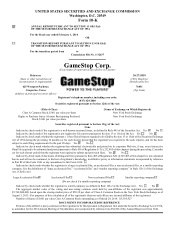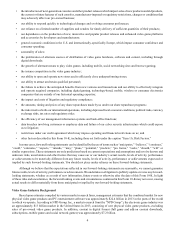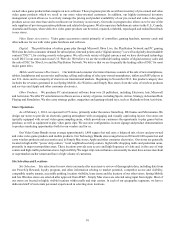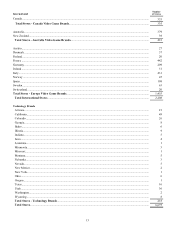GameStop 2013 Annual Report Download - page 22
Download and view the complete annual report
Please find page 22 of the 2013 GameStop annual report below. You can navigate through the pages in the report by either clicking on the pages listed below, or by using the keyword search tool below to find specific information within the annual report.5
International Development Group (“IDG”), a market research firm, estimates that retail sales of video game hardware and
software and PC entertainment software totaled approximately $10.6 billion in Europe in 2013. For 2013, the NPD Group reported
that video game retail sales were approximately $1.0 billion in Canada and $1.0 billion in the Australian market.
New Video Game Products. Video game products appeal to a wide array of consumers, from avid gamers spending many
hours per week playing console gaming systems to casual game players enjoying social and mobile games on smart phones, tablets
and other devices. The average game player is 30 years old, 68% are age 18 or older and 45% of gamers are female. We expect
the following trends in sales of video game products:
• Video Game Hardware. Gaming consoles are typically launched in cycles as technological developments provide
significant improvements in graphics, audio quality, gameplay, internet connectivity, social features and other entertainment
capabilities beyond video gaming. The most recent cycle of consoles (referred to as “next generation”) includes the Sony
PlayStation 4 and Microsoft Xbox One, which both launched in most of the countries in which we operate in November
2013, and the Nintendo Wii U, which launched in November 2012. Early demand for the PlayStation 4 and Xbox One has
been strong as sales exceeded our expectations since introduction.
The previous generation of consoles was launched in 2005 (the Microsoft Xbox 360) and 2006 (the Sony PlayStation 3
and the Nintendo Wii). Sony and Microsoft continue to manufacture the PlayStation 3 and the Xbox 360, respectively,
while Nintendo has stopped manufacturing the Wii. The demand for the previous generation hardware has been in decline
since 2011 and we expect that demand will continue to decline as consumers move to the next generation consoles.
In addition, portable handheld video game devices have evolved to the Nintendo 3DS and 2DS, which were introduced
in 2011 and 2013, respectively, and the Sony PlayStation Vita, which was introduced in February 2012. The market for
handheld devices has declined in recent years as the proliferation of smart-phones, tablets and other mobile devices offer
video game players alternative ways to play games.
• Video Game Software. Sales of video game software generally increase as gaming platforms mature and gain wider
acceptance. Sales of video game software are dependent upon manufacturers and third-party publishers developing and
releasing game titles for existing game platforms. In recent years the number of new games introduced each year has
generally declined and as a result, the market for video game sales has also declined. With the introduction of the next
generation consoles, we expect the number of new games introduced to increase and we expect demand for software for
those devices to be strong and demand for software for the previous generation of consoles to continue to decline.
• Video Game Accessories. Sales of video game hardware also drive sales of video game accessories for use with the
hardware and software. The most common video game accessories are controllers and gaming headsets. We expect demand
for video game accessories for use on the next generation of consoles to increase as the installed base of these consoles
increases. We expect the demand for accessories for use with the previous generation of consoles to decline as the sales
of those consoles decline.
Pre-owned and Value Video Game Products. The installed base of video game hardware platforms continues to increase
each year and continues to fuel the market for pre-owned video game hardware and software. Based on reports published by the
NPD Group, we believe that, as of December 2013, the installed base of next generation and the most recent previous generation
video game hardware systems in the United States, based on original sales, totaled over 200 million units of handheld and console
video game systems and grew by 16 million units in 2013. According to IDG, the installed base of active hardware systems of the
same generations as of December 2013 in Europe was approximately 158 million units and grew by 12 million units in 2013.
Hardware manufacturers and third-party software publishers have produced a wide variety of software titles for each of these
hardware platforms. Based on internal estimates, we believe that the installed base of video game software units in the United
States currently exceeds 2.45 billion units. As the substantial installed base of video game hardware and software continues to
expand, there is ongoing demand for pre-owned video game products. There is also demand for value-priced video game products,
which can often be obtained as publishers or other retailers seek to reduce excess or slow-moving inventory. As we look to grow
our market share and overall position in the video game industry, we have begun to expand our pre-owned category to include
value video game products that typically include non-new release software purchased at closeout or from liquidation firms and
on occasion includes reprints of old titles from publishers to supplement our inventory. Such products are expected to have the
net effect of increasing our overall pre-owned and value video game product sales at a slightly reduced margin rate with the goal
of increasing overall gross margin dollars and operating profit.
Digital Gaming. The digital game market consists of both immersive and casual games delivered over the internet to
consoles, computers, tablets, smart phones and other devices. The recent generations of video game consoles contain the technology
to digitally download video game software content and a growing market has developed for the sale of digitally downloadable
add-on content for physical games, which the electronic game industry calls “DLC” and, more recently, full game downloads.
The next generation consoles increase the availability and ease of downloading game content and we expect the demand for
downloadable video games to continue to grow as the installed base of the next generation of consoles grows.
























